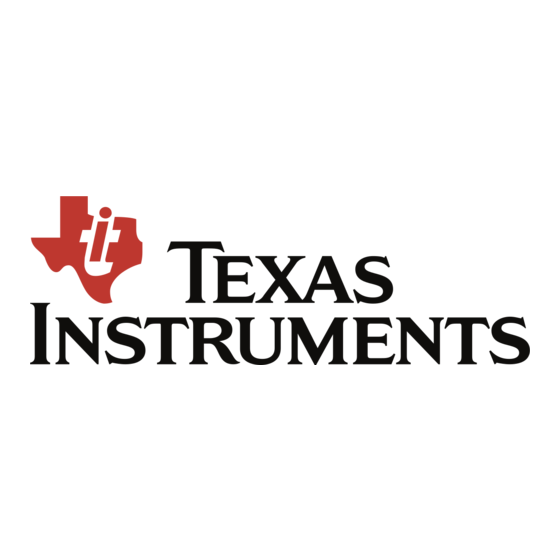
Table of Contents
Advertisement
Quick Links
CC2533EMK Quick Start Guide
1. Kit Contents
2 x CC2533EM with PCB antennas
2 x Pulse W1010 2.4 GHz antennas
Documentation
The RF boards in this kit are FCC and IC certified
and tested to comply with ETSI/R&TTE standards
over temperature from 0 to +35°C. The antenna,
W1010 from Pulse, is a ¼ wave dipole antenna
with 2 dBi gain.
FCC/IC Regulatory Compliance
FCC Part 15 Class A Compliant
IC ICES-003 Class A Compliant
4. Select Power Source
Locate
the
power source
header
P11
just above the
LCD
on
the
SmartRF05EB
Connect pins 1 and 2 if you are using
batteries to power the board. Connect pins
2 and 3 if you are using USB or external
power supply.
Once you have
set P11, find
switch P8 just
next to the DC
jack
on
the
SmartRF05EB.
To
power
on
the board, flip the switch from "OFF" to
"ON".
6 Set up the Receiver
Set one of the boards to operate as
receiver. Use the joystick to select mode.
Confirm by pressing Button 1.
The receiver will now wait for packets from
the transmitter.
1
When using an external power supply, make sure it meets the listed requirements in addition to complying with applicable regional
product regulatory and safety certification requirements such as UL, CSA, VDE, CCC, and PSE.
2. Plug EM into SmartRF05EB
In order to run the pre-programmed packet
error rate test on the device, you need 2
SmartRF05
Evaluation
Boards.
SmartRF05EB is included in the CC2533
Development Kit Error! Reference source
not found..
Note that you DO NOT need the SMA
antenna, as the PCB antenna is used by
default.
4. Packet Error Rate (PER)
When
power
is
applied
SmartRF05EB, the preprogrammed PER
test on the CC2533 will start running.
The LCD will display the screen as shown
in the picture above. The number in the
parentheses is the revision of the CC2533.
Press Button 1 to
continue.
7. Set up the Transmitter
Set the
other
board
to operate
transmitter. Use the joystick to select mode.
Confirm the selection by pressing Button 1.
On
the
transmitter
node,
parameters have to be set. On the next
screen, select the TX output power (signal
strength). Use the joystick to select
between -3 dBm, 0 dBm, 4.5 dBm or 7
dBm. Confirm the selection with Button 1.
3. Power Options
There are several ways of applying power
to the SmartRF05EB;
USB (5V through USB plug)
External Power Supply
(requirements below)
2 x 1.5V AA Non-Rechargeable Alkaline
Batteries
Voltage regulators on the SmartRF05EB
will set the on-board voltage to 3.3V.
The
External Power Supply
Nom Voltage: 4 to 20 VDC
Max Current: 1500 mA
Efficiency Level V
Warning! To minimize risk of personal
injury or property damage, never use
rechargeable batteries to power the board.
5. Select Channel
to
the
Select one of the 16 IEEE 802.15.4
channels, with channel number from 11 to
26 (2405-2480 MHz, 5 MHz channel
spacing). Select the same channel for both
boards.
The channel number is increased by
moving the joystick in any direction.
Press Button 1 to confirm the selection.
8. TX: Packets and Packet Rate
as
Next, select burst size (number of packets
to send) by using the joystick, either 1000,
10K, 100K or 1M packets. Confirm the
selection with Button 1.
additional
After selecting burst size, select packet
rate; 100, 50, 20 or 10 packet per second.
Confirm the selection with Button 1.
SWRU253A
October 2013
1
Requirements:
Advertisement
Table of Contents

Summary of Contents for Texas Instruments CC2533EMK
- Page 1 SWRU253A October 2013 CC2533EMK Quick Start Guide 1. Kit Contents 2. Plug EM into SmartRF05EB 3. Power Options There are several ways of applying power to the SmartRF05EB; USB (5V through USB plug) External Power Supply (requirements below) ...
- Page 2 12. Flash Programmer 13. IAR Embedded Workbench 14. Packet Sniffer Texas Instruments has a simple tool which To develop software, program and debug In order to debug RF protocols, it is possible to use TI’s SmartRF Packet can be used to program the flash on the...
- Page 3 Any exceptions to this are strictly prohibited and unauthorized by Texas Instruments unless user has obtained appropriate experimental/development licenses from local regulatory authorities, which is responsibility of user including its acceptable authorization.
- Page 4 FCC Interference Statement for Class B EVM devices This equipment has been tested and found to comply with the limits for a Class B digital device, pursuant to part 15 of the FCC Rules. These limits are designed to provide reasonable protection against harmful interference in a residential installation. This equipment generates, uses and can radiate radio frequency energy and, if not installed and used in accordance with the instructions, may cause harmful interference to radio communications.
- Page 5 Also, please do not transfer this product, unless you give the same notice above to the transferee. Please note that if you could not follow the instructions above, you will be subject to penalties of Radio Law of Japan. Texas Instruments Japan Limited (address) 24-1, Nishi-Shinjuku 6 chome, Shinjuku-ku, Tokyo, Japan http://www.tij.co.jp...
- Page 6 FDA Class III or similar classification, then you must specifically notify TI of such intent and enter into a separate Assurance and Indemnity Agreement. Mailing Address: Texas Instruments, Post Office Box 655303, Dallas, Texas 75265 Copyright © 2013, Texas Instruments Incorporated...










Need help?
Do you have a question about the CC2533EMK and is the answer not in the manual?
Questions and answers